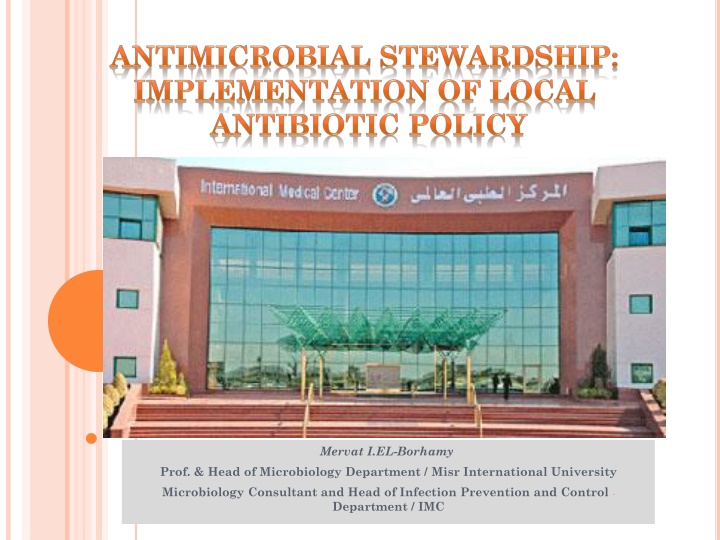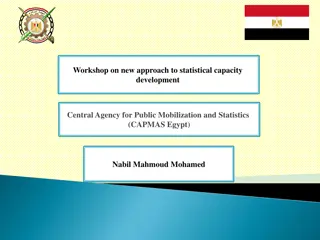
Antimicrobial Stewardship and Resistance in Healthcare Settings
Explore the role of Antimicrobial Stewardship in combating the abuse of antibiotics, preventing Multi-Drug Resistant Bacteria, and ensuring rational use of antibiotics. Learn why Antimicrobial Resistance is a crucial issue in Hospital-Acquired Infections, affecting patient treatment outcomes and healthcare costs. Discover strategies for evidence-based practice guidelines and implementing proper antimicrobial therapies to combat resistance effectively.
Download Presentation

Please find below an Image/Link to download the presentation.
The content on the website is provided AS IS for your information and personal use only. It may not be sold, licensed, or shared on other websites without obtaining consent from the author. If you encounter any issues during the download, it is possible that the publisher has removed the file from their server.
You are allowed to download the files provided on this website for personal or commercial use, subject to the condition that they are used lawfully. All files are the property of their respective owners.
The content on the website is provided AS IS for your information and personal use only. It may not be sold, licensed, or shared on other websites without obtaining consent from the author.
E N D
Presentation Transcript
Mervat I.EL-Borhamy Prof. & Head of Microbiology Department / Misr International University Microbiology Consultant and Head of Infection Prevention and Control Department / IMC -
ANTIMICROBIAL STEWARDSHIP Multidisciplinary development of evidence- based practice guidelines incorporating local microbiology data and resistance patterns Improve antimicrobial utilization
THE LEADING CAUSE OF MDR Abuse of antibiotics: Unnecessary use or overuse Development of MDR Increase in hospital length of stay Increase in healthcare costs
ABUSE OF ANTIBIOTICS Using multiple antibiotics when one would be sufficient Unnecessarily long courses of antibiotic therapy Use antibiotics in self-limited infections Overuse antibiotics for prophylaxis before and after surgery In many countries, antibiotics are sold over the counter to the general public Antibiotics are used in animal feed to prevent infection and promote growth
WHY IS ANTIMICROBIAL RESISTANCE IMPORTANT IN HAIS ?? PROGNOSIS for successful treatment of the patient is worse than with susceptible organisms Special efforts to control HOSPITAL SPREAD of resistant organisms may be required LIMITS TREATMENT choice, which is especially important with patients who have drug allergies
Multi Drug Resistant Bacteria MRSA VRE KPCR ESBL PRP
RATIONAL USE OF ANTIBIOTICS Establishment of RAP is a key issue Better care of patients Decrease antimicrobial resistance Decrease in hospital length of stay Decrease in healthcare costs
RATIONAL USE OF ANTIMICROBIAL THERAPY By maintaining sufficiently high level of the drug in tissues Each hospital needs its own policy since the prevalence of resistant strains, plasmids, etc will vary to some extent from hospital to hospital Limit the use of some drugs Avoidance of topical use of valuable antibiotics,e.g. Gentamycin The use of antibiotic prophylaxis only when strictly indicated Proper use of antibiotic combinations
GENERAL PRINCIPLES OF ANTIMICROBIAL USE Prophylactic Empiric Directed
EMPIRIC THERAPY No definitive information about the causative pathogen The patient is sufficiently ill to warrant treatment before ABS test results are available Broad spectrum antibiotics The clinical site of infection (UTI, LRTI,..) and host factors (HIV, organ transplant) give an indication of likely pathogens
ANTIBIOTIC COMBINATIONS Use a single drug unless it has been proven that combination therapy is required: 1 In empiric therapy to treat serious infections before I.D. of the organism To achieve a synergistic inhibitory effect (e.g.Penicillin or vancomycin and Gentamycin for enterococcal endocarditis) 2 To prevent the emergence of resistant organisms (treatment of M.tuberculosis) 3
GUIDED DIRECTED THERAPY Known ABS test Known infecting agent 1 Therapy is selected: to the most effective, least toxic and narrow spectrum antibiotic 2 Minimize the cost of therapy: when equivalent alternatives are available Duration of therapy: as short as possible 3
KEY COMPONENTS OF ANTIBIOTIC POLICY Communication: Improved communication between labs, treating clinicians, and pharmacy Local sensitivity patterns: Laboratories should regularly make local sensitivity patterns widely known and routinely should only report on those agents which appear in the policy Time factor: Susceptibility and culture results should be reported to clinicians with the minimum of delay to allow them to continue or stop antibiotic therapy as appropriate Education programme: Microbiology and Pharmacy departments should have adequate facilities to ensure that education programme can be carried out Computer facilities: Computer facilities should be available for audit
TEAM WORK Information flow has to be rapid (phone and personal contact) Microbiologist PATIENT Clinician & Clinical pharmacist ICP
PLAN OF THE WORK Collection of culture and antibiotic sensitivity results data for at least four months in a give time period Site: e.g ICUs or words Specimens: all types of clinical specimens or select one of them 20
Percentage of GPB and GNB GPB 18% GNB 82% Total number of tested bacteria is 290 21
Distribution of bacteria in IMC 60% 49% 50% 40% GNB 30% GPB 19% 20% 14% 10% 5% 4% 3% 2% 2% 1.50% 0.50% 0 0 0% OTHERS 2C 1B 1C,3C,GC ICUC,G,F ICUD 22
DISTRIBUTION OF GRAM NEGATIVE BACTERIA IN IMC 50.00% 45.50% 45.00% 40.00% 35.00% 30.00% 25.00% 19% 18.50% 20.00% 15.00% 10.00% 8% 5% 5.00% 3% 3% 1% 1% 1% 0.00% Achrom Stenotr Burkho Serratia Proteus Enterob Pseudo Acineto E.coli Klebs 23
DISTRIBUTION OF GRAM POSITIVE BACTERIA IN IMC 80% 72% 70% 60% 50% 40% 30% 20% 13% 13% 10% 2% 0% Enterococcus CNS S.aureus MRSA 24
Percentage of MDR / 2015 NON MDR 27% MRSA 2% MDR/GNB 71% 25
OVERALL PERCENTAGE OF MDR - 2015 MDR (Gram -ve) total isolates / total GNB / same spp / E.Coli (ESBL) Klebsiella (ESBL) Psudomonas (MDR) Acinetobacter(MDR) Enterobacter (MDR) MDR (Gram +ve) 11% 37% 6% 15% 2% /total isolates 13.5% 45% 7% 18.5% 3% /total GPB 71% 99% 89% 100% 58% /S.aureus 2% MRSA 13% 88% 27
DISTRIBUTION OF GRAM NEGATIVE MDR IN DIFFERENT DEPARTMENTS 10% 3% 27% ICU-D ICU-C,G,F 1C,3C,GC OTHER F 60% 28
DISTRIBUTION OF MRSA IN DIFFERENT DEPARTMENTS 86% 0.9 0.8 0.7 0.6 0.5 0.4 0.3 14% 0.2 0.1 0 0 0 OTHER F 1C,3C,GC ICU-C,G,F ICU-D 29
PERCENTAGE OF CLINICAL SITES OF INFECTION IN ICU-D 48% 50% 45% 40% 35% 29% 30% 25% 20% 12% 11% 15% 10% 5% 0% SSI UTI RTI BSI 37
Distribution of bacteria in ICU-D 70% 59% 60% 50% 40% 30% 20% 18% 11% 10% 8% 5% 1.50% 0% CNS All bacterial isolates in ICU-D are MDR Enterobac Pseud Acineto E.coli Klebsiella 38
PERCENTAGE OF BACTERIA CAUSING BSI IN ICU-D Enteroc CNS 39% S.aureus MRSA Stenotr Burkho Serratia Proteus Enterob Pseudo Acineto 17% E.coli Klebs 44% 50% 45% 40% 35% 30% 25% 20% 15% 10% 5% 0% 39
PERCENTAGE OF BACTERIA CAUSING RTI IN ICU-D Enteroc CNS S.aureus MRSA Stenotr Burkho Serratia Proteus Enterob Pseudo 12% Acineto 15% E.coli Klebs 63% 70% 60% 50% 40% 30% 20% 10% 0% 40
PERCENTAGE OF BACTERIA CAUSING UTI IN ICU-D Enteroc CNS S.aureus MRSA Stenotr Burkho Serratia Proteus Enterob Pseudo 12.50% Acineto E.coli 12.50% Klebs 75% 80% 70% 60% 50% 40% 30% 20% 10% 0% 41
PERCENTAGE OF BACTERIA CAUSING SSI IN ICU-D Enteroc CNS S.aureus MRSA Stenotr Burkho Serratia Proteus Enterob 43% Pseudo Acineto 28.50% E.coli Klebs 28.50% 50.00% 45.00% 40.00% 35.00% 30.00% 25.00% 20.00% 15.00% 10.00% 5.00% 0.00% 42
ANTIBIOTIC SUSCEPTIBILITY PERCENTAGE OF GRAM NEGATIVE BACTERIA (MDR)IN ICUD A M P AM P/S UL B A U G PIP /TA ZO CE F CX M CX M/ AX CE FP OD CT X CA Z CR O CF P A Z T ERT IPM M E M G M CI P M OX TE T TG C SX T 0 7 % 0 14 % 0 0 0 0 0 0 0 0 0 16 % 14 % 14 % 23 % 20 % 20 % 17 % 73 % 6 % KLE B Acin eto 0 0 N T 0 N T 0 0 0 0 0 0 0 0 0 0 0 27 % 0 0 0 55 % 0 PSE UD O 0 0 0 50 % 0 0 0 0 0 25 % 0 0 N T NT 0 0 67 % 0 0 0 N T 0 Ent er N T NT N T 0 N T 0 0 0 0 0 N T N T N T 0 0 0 0 0 0 67 % 67 % 67 % All gram negative bacterial isolates in ICU-D are MDR 43
ANTIBIOTIC SUSCEPTIBILITY PERCENTAGE OF GRAM POSITIVE BACTERIA IN ICUD P AMP OX GM CIP LEV MOX E CL QUI NO LZD VA TET TG C RF SXT AB/O RG CNS 0 0 0 86 % 29 % 29 % 57 % 29 % 0 71 % 100 % 100 % 86% 100 % 43% 43% 44
EMPIRIC ANTIBIOTIC THERAPY OF BSI IN ICU-D 0.8 70% 0.7 0.6 0.5 40% 40% 40% 0.4 30% 30% 30% 30% 0.3 20% 0.2 10% 0.1 0% 0% 0 0% 0 0% 0 0 45
EMPIRIC ANTIBIOTIC THERAPY OF BSI IN ICU-D (CNS) 1.2 100% 100% 100% 1 86% 86% 0.8 71% 57% 0.6 43% 43% 0.4 29% 29% 29% 0.2 0% 0 0 0 0 SXT RF TGC TET VA LZD QUIN CL E MOX LEV CIP GM OX AMP P 46
EMPIRIC ANTIBIOTIC THERAPY OF RTI IN ICU-D 0.6 54% 0.5 0.4 29% 0.3 0.2 11% 11% 0.1 7% 7% 7% 4% 4.00% 4% 4% 0 0 0 0 0 0 0 47
EMPIRIC ANTIBIOTIC THERAPY OF UTI IN ICU-D 0.25 22% 22% 22% 22% 0.2 0.15 11% 11% 11% 11% 11% 0.1 0.05 0 0 0 0 0 0 0 48
EMPERIC ANTIBIOTIC THERAPY OF SSI IN ICU-D 0.6 56% 0.5 0.4 0.3 22% 22% 0.2 0.1 0% 0 0 0 0 0 0 0 0 0 0 0 0 0 0 49
( 3 ) LEVELS OF ANTIBIOTICS First choice antibiotics: - to be prescribed by all doctors 51 Restricted choice antibiotics: - for MDR, polymicrobial infections, patient conditions need special attention, more expensive antibiotics Reserve antibiotics: - for life threatening infections, to be used after permission from a TC member
IMPLEMENTATION OF RESTRICTED ANTIBIOTIC POLICY Restricted antibiotics can be ordered by the attending consultants or his registrar after permission 52 The drug will be automatically stopped unless approved by the clinical pharmacist It is the responsibility of the treating consultant to arrange for approval of the prescription by the clinical pharmacist After approval from the pharmacy, the pharmacy will provide antibiotics for three working days
IMPLEMENTATION OF RESTRICTED ANTIBIOTIC POLICY-CONT D In the third day culture and sensitivity result should be provided to the pharmacy to continue providing the antibiotics 53 Duration of therapy: either 10-14 days in total or until 3- 5 days after clinical improvement The antibiotic committee will review this policy regularly
STEPS: 1- 8 Break the chain of infection (prevent transmission/isolate the pathogen) Stop treatment when cured (treat effectively) 55 Know when to say no to vancomycin (use antimicrobials wisely) Treat infection, not colonization Use local data Access the experts Target the pathogen Use devices properly: IVD, Folley s catheter, Ventilators)
Antimicrobial Creed: MIND ME Microbiology guide therapy whenever possible M M Minimize duration of therapy Indications should be evidence- based I N Narrowest spectrum required Ensure monotherapy in most situations D E Dosage appropriate to site and type of infection 56
THANK YOU 57

![[PDF⚡READ❤ONLINE] Tutankhamun's Trumpet: Ancient Egypt in 100 Objects from the](/thumb/20549/pdf-read-online-tutankhamun-s-trumpet-ancient-egypt-in-100-objects-from-the.jpg)




















